 |
| Singer sewing machines first logo (1870) |
Name:
"Singer sewing machine"
Category: Home
Subcategory: Manufacturing
Inventor: Isaac Merritt Singer
Invented: 1850 - Boston, Mass., USA
Patented: August 12, 1851
Producer:
--- "Singer & Phelps", Boston, Mass. (founded in 1850 by Isaac Merritt Singer, Orson C. Phelps, and George B. Zieber to sell the first machines in Phelps's shop)
--- "I. M. Singer & Co.", New York City (founded in 1851 by Isaac Merritt Singer and lawyer Edward Clark, renamed "Singer Manufacturing Company" in 1863, then "The Singer Company" in 1963)
--- "Singer & Phelps", Boston, Mass. (founded in 1850 by Isaac Merritt Singer, Orson C. Phelps, and George B. Zieber to sell the first machines in Phelps's shop)
--- "I. M. Singer & Co.", New York City (founded in 1851 by Isaac Merritt Singer and lawyer Edward Clark, renamed "Singer Manufacturing Company" in 1863, then "The Singer Company" in 1963)
Production start: 1851 - New York City
First price: According to the first newspaper advertisement (1850, see below), the first Singer sewing machines «complete, with all appendages for operation» were sold for 125 US dollars
Features: In the summer of 1850, analyzing the flaws of the Lerow and Blodgett sewing machine, Isaac Merritt Singer devised a machine that used a shuttle that moved in a straight path—as opposed to theirs, which moved around in a complete circle. He visualized replacing their curved horizontal needle with a straight, vertically moving needle. Singer worked on perfecting his machine, and at the end of 1850 submitted a commercial sewing machine for his first patent model. On August 12, 1851, he was granted Patent No. 8,294. These commercial sewing machines were built in a machine shop owned by Orson C. Phelps at 19 Harvard Place in Boston. The head, base cams, and gear wheels of the machine were made of cast iron; to fit together, these parts had to be filed and ground by hand. The machine made a lockstitch by using a straight, eye-pointed needle and a reciprocating shuttle. The specific patent claims allowed were for: 1) the additional forward motion of the shuttle to tighten the stitch; 2) the use of a friction pad to control the tension of the thread from the spool; and 3) placing the spool of thread on an adjustable arm to permit thread to be used as needed. Overall measures: 16 in x 17 in x 12 in; 40.64 cm x 43.18 cm x 30.48 cm.
By November 1850, a three man enterprise - Isaac M. Singer, Orson C. Phelps (owner of the machine shop in Boston), and George B. Zieber (Singer's financier and partner), identifying themselves as the I. M. Singer & Co., placed advertisements in several newspapers proclaiming the amazing abilities of the «Singer & Phelps's Belay-stitch Sewing Machine».
What set Singer's machine apart from the other machines was that the Singer innovation was truly beneficial to the seamstress. According to a sewing machine historian, a practical working sewing machine required essential features: the lockstitch, an eye-pointed needle, a shuttle for the second thread, continuous thread from spools, a horizontal table, an overhanging arm, continuous feed, thread or tension control, a presser foot, and the ability to sew in a straight or curving line. Although, Singer did not invent or patent all of these essential features, he did incorporate them into his machine. He combined his predecessors' inventions with his own to create a practical and useful sewing machine. The ability to incorporate these features into one machine gave the Singer machine the clear advantage. Other machines possessed some of these features but not all. Additionally, the time spent in Phelps's workshop proved that the Lerow and Blodgett machine required a skilled mechanic to keep it functioning, whereas the Singer machine did not require a mechanic to keep it operational: it was even guaranteed to work for a full year without repairs.
By November 1850, a three man enterprise - Isaac M. Singer, Orson C. Phelps (owner of the machine shop in Boston), and George B. Zieber (Singer's financier and partner), identifying themselves as the I. M. Singer & Co., placed advertisements in several newspapers proclaiming the amazing abilities of the «Singer & Phelps's Belay-stitch Sewing Machine».
What set Singer's machine apart from the other machines was that the Singer innovation was truly beneficial to the seamstress. According to a sewing machine historian, a practical working sewing machine required essential features: the lockstitch, an eye-pointed needle, a shuttle for the second thread, continuous thread from spools, a horizontal table, an overhanging arm, continuous feed, thread or tension control, a presser foot, and the ability to sew in a straight or curving line. Although, Singer did not invent or patent all of these essential features, he did incorporate them into his machine. He combined his predecessors' inventions with his own to create a practical and useful sewing machine. The ability to incorporate these features into one machine gave the Singer machine the clear advantage. Other machines possessed some of these features but not all. Additionally, the time spent in Phelps's workshop proved that the Lerow and Blodgett machine required a skilled mechanic to keep it functioning, whereas the Singer machine did not require a mechanic to keep it operational: it was even guaranteed to work for a full year without repairs.
Interesting facts: Son of poor German immigrants, Isaac Singer was born on October 27, 1811, in Pittstown, New York. As a young man he worked as a mechanic and cabinetmaker. For a time he was an actor and formed his own theatrical troupe, "The Merritt Players". Needing a steadier income, Singer worked for a plant in Fredericksburg, Ohio, that manufactured wooden type for printers. Seeing the need for a better type-carving machine, he invented an improved one. In June 1850, Singer took the machine to Boston looking for financial support. He rented display space in the workshop of Orson C. Phelps. Here Singer became intrigued with the sewing machine that Phelps was building for John A. Lerow and Sherburne C. Blodgett. The result of this new passion - the birth of the first Singer sewing machine, can be explored in the "Features" section above, and by images below.
The machine incorporated the basic eye-pointed needle and lock stitch, developed by inventor Elias Howe: in 1851, immediately after the registration, he asked Singer to pay 2,000 dollars for the use of his patent. Meanwhile, Singer was looking for a new partner, and with Howe's accusations circling, it was advantageous to look for a partner with legal talents. Singer found Edward Clark, a respectable and skilled New York lawyer, who becomes co-founder of the "I. M. Singer & Co.". Singer and Clark actively fought the infringement; however, the courts ruled in favor of Howe. In 1854, after three years of litigation, Howe was rewarded $15,000 in damages, and royalties of $25 per machine. When Howe's patent expired, he had received royalties up to $2,000,000.
In 1855 the Singer brand was awarded the first prize at the World’s Fair in Paris, France. That same year, Singer became the largest selling brand of sewing machines internationally. In 1865 Singer brand introduces the new "Family” Sewing Machine, in 1870 the Red "S" girl trademark, in 1889 the first practical electric sewing machine, and in 1890 Singer brand reaches 90% market share globally.
The machine incorporated the basic eye-pointed needle and lock stitch, developed by inventor Elias Howe: in 1851, immediately after the registration, he asked Singer to pay 2,000 dollars for the use of his patent. Meanwhile, Singer was looking for a new partner, and with Howe's accusations circling, it was advantageous to look for a partner with legal talents. Singer found Edward Clark, a respectable and skilled New York lawyer, who becomes co-founder of the "I. M. Singer & Co.". Singer and Clark actively fought the infringement; however, the courts ruled in favor of Howe. In 1854, after three years of litigation, Howe was rewarded $15,000 in damages, and royalties of $25 per machine. When Howe's patent expired, he had received royalties up to $2,000,000.
In 1855 the Singer brand was awarded the first prize at the World’s Fair in Paris, France. That same year, Singer became the largest selling brand of sewing machines internationally. In 1865 Singer brand introduces the new "Family” Sewing Machine, in 1870 the Red "S" girl trademark, in 1889 the first practical electric sewing machine, and in 1890 Singer brand reaches 90% market share globally.
Slogan (1892): «All Nations use Singer Sewing Machines»
Property: I. M. Singer & Co., Singer Manufacturing Company, The Singer Company
Producer website: https://www.singer.com
 |
| Singer sewing machines, first newspaper advertisement (Burlington free press, Burlington, Vt., November 8, 1850). «Sewing by Machinery. To Journeymen Tailors, Sempstresses, Employers, and all others intersted in Sewing of any description. SEVERAL ATTEMPTS have been made to produce Machinery for Sewing, but they were not whitout many objections, and could be used to little advantage or profit. Singer & Phelp's Belay stitch Sewing Machine, invented by Isaac M. Singer, and manufactured by Singer & Phelp's, No. 19 Harvard Place, Boston, Mass., is offered to the public as a perfect machine, and will be constructed and adapted to perform any kind of work, from the stitching of a fine shirt-bosom to a ship's sail, as well as some descriptions of leather. The needle is straight, and works perpendicularly upon the table of the machine, affording room and opportunity to adjust the fabric in any way - and the stitch may be regulated to any length, even to a hair's breadth. The stitch made by this machine is one which will not ravel or open, and the sewing can only be taken apart by cutting every second or third stitch. From 500 to 1500 stitches, according to the fabric operated upon, may be taken per minute. To bring this machine to perfection, much labor and study have been expended upon it by the inventor, and the subscribers now offer the Belay-stitch Sewing Machine, feeling confident that it will correspond, upon trial, with the recommendation here given. The profits arising from the use of one of these machines, which sews with either one or two needles, is from five to six dollars per day. The operation is not confined to the manufacture of clothing only, but may be applied to sewing every description of linen, cotton, woolen, and most kinds of leather. The machine, with ordinary care, is warranted to run one year without repairs, and will last many years. And it is so simple in its construction, and so easily regulated and managed, that any person of ordinary ability may operate it. The price of one of these sewing machines, which is worked by treadle, and capable of sewing any ordinary linen, muslin, or woolen fabric, is one hundred and twenty-five dollars, complete, with all appendages for operation. These machines are so beautiful and neat in their appearance, and they take up so little room, that they are an ornament to any lady's sewing apartment. An Agent, (with whom exclusive arrangements will be made,) is wanted in every city and town in the United States. All applications for Agencies, and all orders enclosing the money for machines, (which will be carefully packed to send to any part of the world,) as well as all enquiries about their adaptation to different purposes, will be promptly attended to by the manufacturers. All letters must be post-paid, and addressed to SINGER & PHELPS, 19 Harvard Place, Boston, Mass. - Nov. 5, 1950.» |
 |
| Singer sewing machines, prototype (1850). Cast iron (heavy: est. 75 lbs), square machine. The head is unpainted, plain, metal finish. Lockstitch machine, shuttle is missing. |
 |
 |
| Singer sewing machines, patent model (1851) |
 |
 |
 |
 |
| Singer sewing machines, images from Patent granted to Isaac M. Singer (August 12, 1851) |
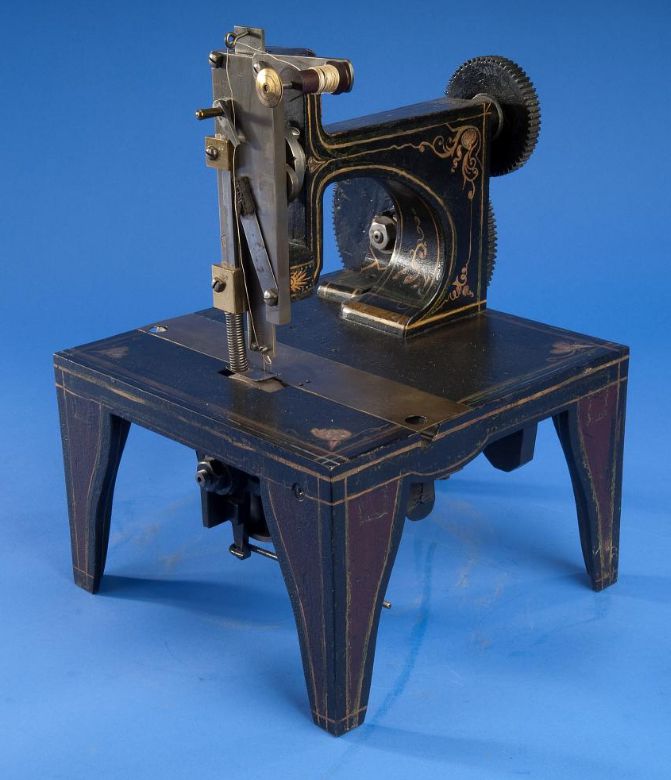 |
 |
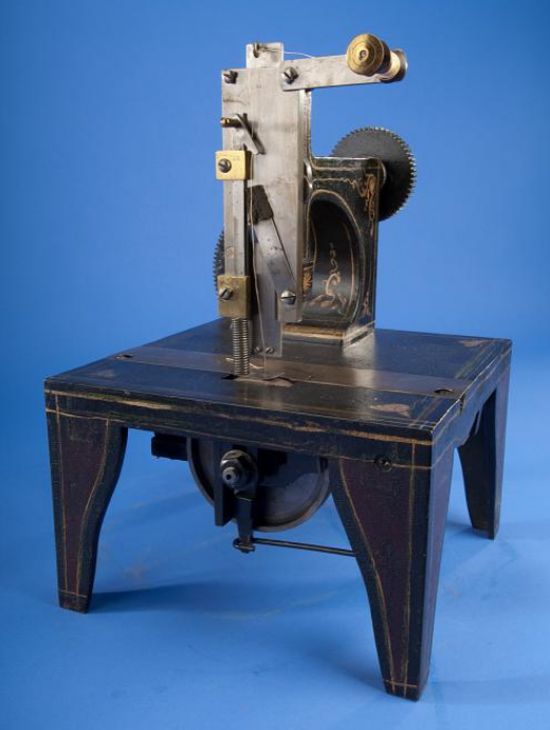 |
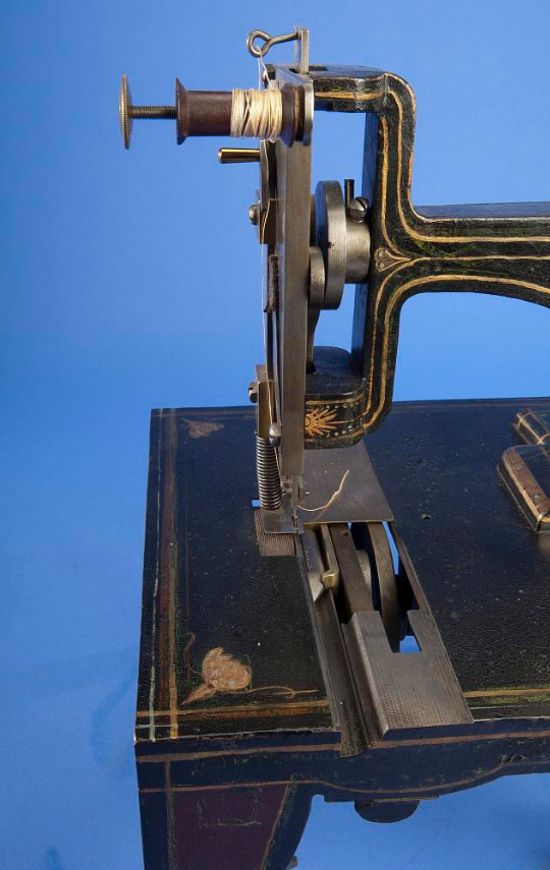 |
 |
 |
| Singer sewing machines, patent model overview and details (1851) |
 |
| Singer sewing machines, first showroom and headquarters located at 458 Broadway, New York City (1857) |
 |
| Singer sewing machines, "Letter A" model (1859-1865) |
 |
| Singer sewing machines, 12K "Family" model with instruction manual (1865-1883, the machine pictured dates back to 1873) |
 |
| Singer sewing machines, newspaper advertisement (The Emporia news., Emporia, Kan., January 1, 1869) |
 |
| Singer sewing machines, trade card featuring the Statue of Liberty (1883). This Singer trade card shows the Bartholdi Statue (as it was then known) before it was completed. Front: «THE "NEW SINGER"». Back: «THE BARTHOLDI STATUE. "LIBERTY ENLIGHTENING THE WORLD." (...) THE SINGER MANUFACTURING COMPANY, Agencies in all important Towns and Cities throughout the World». |
 |
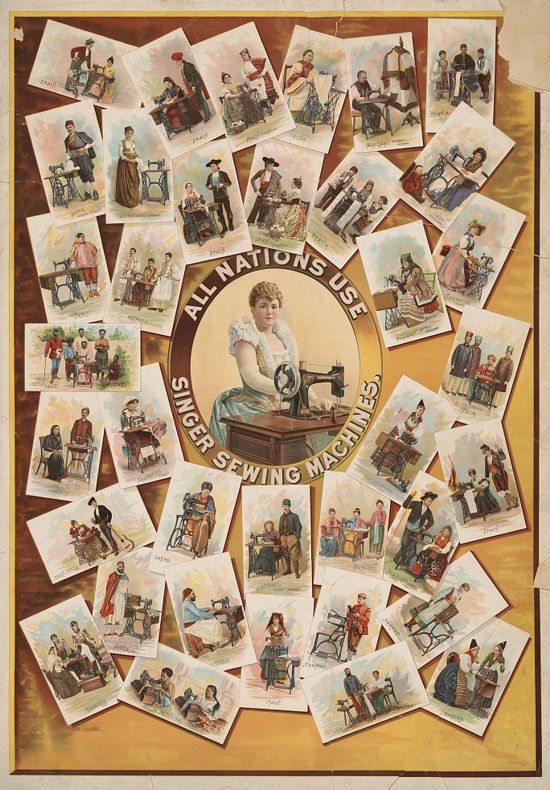 |
| Singer sewing machines, advertisement posters «All nations use Singer sewing machines» (Singer Manufacturing Co., 1892) |
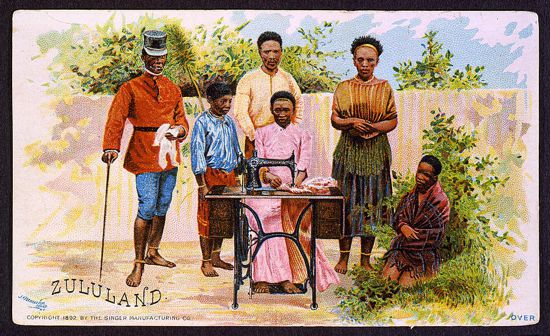 |
 |
 |
| Singer sewing machines, advertisement cards distributed at World Columbian Exposition, Chicago, 1893 (Singer Manufacturing Co., 1892 by J. Ottmann Lith. Co., N.Y.) |
 |
| Singer sewing machines, advertisement card titled «The first lesson on the Singer sewing machine» (Singer Manufacturing Co., 1893). Front: «The new improved Singer. Easy to use - easy to learn - easy to buy». Back: «Founded 1850. Progressing 1893. Over eleven million Singer sewing machines have been made and sold. Why the unprecedented success of this ideal machine? The answer comes echoing back from millions of homes that the Singer excels in all kinds of family sewing and art work. - It has: The shortest needle. The finest and simplest stitch adjustement. The best "balanced tension". The greatest number of labor-saving modern improvements. The simplest self-threading shuttle. The best automatic bobbin-winder. The greatest capacity for all kinds of family sewing. Prices within the reach of all. Liberal terms on monthly payments. The Singer Manufacturing Company». |
 |
| Singer sewing machines, advertisement card titled «The "Singer" Dorcas Society» (Singer Manufacturing Co., 1895). «Singer family sewing machines are so simple and light running that even the youngest children can easily learn how to sew on them». |
 |
| Singer sewing machines, French advertisement «La Compagnie "SINGER" Machines à Coudre» (J.E. Goossens, Paris, ca. 1895) |
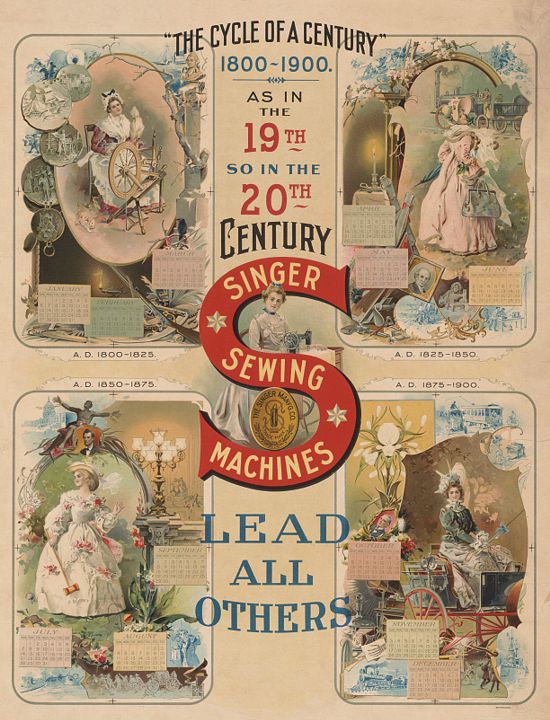 |
| Singer sewing machines, advertisement: «The cycle of a century 1800-1900. Singer sewing machines lead all others» (Singer Manufacturing Co., ca. 1900) |
 |
| Isaac Merritt Singer (Pittstown, New York, USA, October 27, 1811 - Paignton, Devon, UK, July 23, 1875), actor, businessman, inventor of the Singer sewing machine and founder of I. M. Singer & Co. in 1851 (oil on canvas by Edward Harrison May, 1824-1887) |
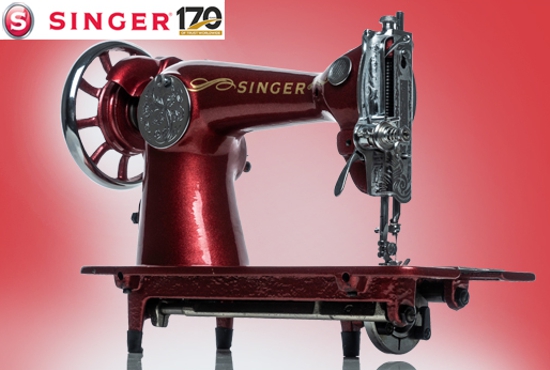 |
| Singer celebrates its 170th Anniversary (1851-2021) introducing a Limited Edition 170th Anniversary Vintage 15-class cast-iron machine in both black and red versions |
